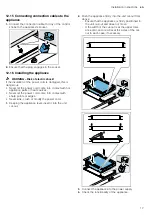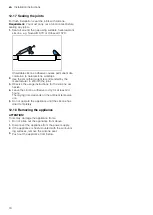
en
Basic operation
6
Clean the appliance and accessories.
5.1 Heating up the appliance
▶
To eliminate the new-appliance smell, heat up the
empty appliance at 200 °C for a few minutes.
Smoke development and odour development are
normal.
Ventilate the installation room well.
6 Basic operation
6.1 Switching on the appliance
1.
Push in the right-hand control knob and turn it
clockwise or anti-clockwise to the required temperat-
ure between 120–240 °C .
a
The illuminated ring on the control knob flashes
while the appliance is heating up.
2.
Push in the left-hand control knob and select the re-
quired cooking zone to heat up only the front or rear
cooking zone or the entire frying surface.
3.
Wait until the set temperature has been reached.
a
The illuminated ring on the control knob lights up
continuously.
4.
Use the spatula or a heat-resistant brush (e.g. silic-
one brush) to spread a little oil or fat evenly over the
frying surface.
5.
Place the food directly onto the frying surface.
‒
Do not use pots or pans.
6.
Use the spatula supplied to turn the food.
6.2 Switching off the appliance
WARNING ‒ Risk of burns!
The appliance remains hot for a long time after it is
switched off.
▶
Do not touch the appliance while the residual heat
indicator is lit.
▶
Turn the control knob to 0.
6.3 Switching on the keep warm function
You can keep food warm on the keep warm function.
1.
Turn the right-hand control knob to .
2.
Use the left-hand control knob to select the entire
frying surface, only the front or the rear cooking
zone.
7 How it works
You can find the right settings for different food here as
well as helpful comments. We have perfectly tailored
these recommendations to your appliance.
7.1 Tips for boiling and frying
¡
Do not place the food on the appliance until the
heating display has gone out. When increasing the
temperature between two preparations, do not place
the food until the heating display has gone out.
¡
Use the spatula to press the meat, poultry and fish
pieces flat on the frying surface. In order not to des-
troy fibres, do not turn the food until it is easily de-
tached from the plate. Otherwise, liquid may leak
out, causing the food to dry out.
¡
When roasting, ensure that the pieces of meat,
poultry and fish do not touch each other. Otherwise,
the food may draw out liquid.
¡
Do not pierce or cut the meat while cooking it, oth-
erwise meat juice may escape.
¡
To prevent water and soluble nutrients from escap-
ing, do not add salt to meat, poultry or fish until it
has been fried.
¡
Before frying, you can roll fish fillets in flour so that
the fish fillet sticks less firmly.
¡
Fry fish fillets on the skin side first. If possible, only
turn the fish fillet once.
¡
Only use oils and fats that can be heated to a high
temperature and are suitable for frying, e.g. refined
plant oils or clarified butter.
¡
The frying surface is hotter in the centre than in the
edge area. If you are cooking food with different
cooking times and temperature requirements at the
same time, you can arrange the food optimally on
the plate.
Also take note of the different temperatures for the
frying surface when selecting the quantity of food.
The thinner the food, the higher the temperature and
the shorter the cooking time.
¡
When working with only one heating zone, select the
highest setting in each case for the temperature
range specified in the cooking table. Alternatively,
you can set 10 °C more than you are used to from
preparing using both heating zones. Use approx.
half of the specified quantity.































